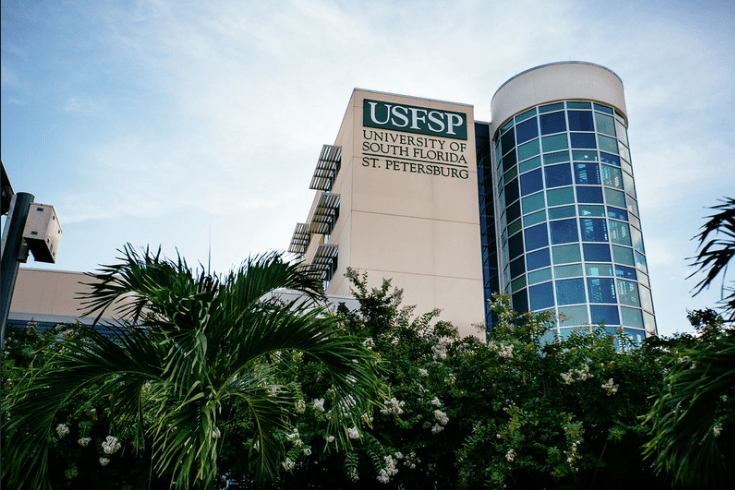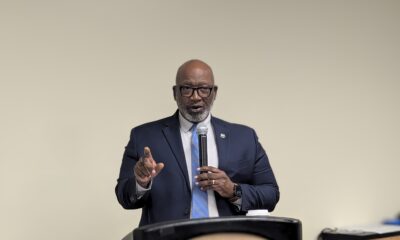Thrive
St. Pete 2.0: Understanding the role of USF’s St. Petersburg campus in the community [survey results]

The St. Petersburg renaissance has been in full swing for more than a decade. We’ve excelled in many areas and struggled in others. In our series St. Pete 2.0, we’re partnering with the St. Petersburg Downtown Partnership to explore what lies on the other side of our potential – what will it take to move to the “next level” as a city? Through this series, we’ll dig into specific topics with the hope that you, our thoughtful citizens, will share your insight, experience and wisdom.
2020 has been a transformative year for the University of South Florida’s St. Petersburg campus. In July, the small waterfront school joined its counterparts in Sarasota-Manatee and Tampa under a single accreditation. At the same time, the university was faced with significant budget cuts and challenged to up its declining enrollment in 2021 while dealing with the unprecedented impact of the Covid-19 pandemic.
Ensuring that USF’s St. Petersburg campus can remain vibrant is critical for community prosperity, entrepreneurship and economic expansion, which is why the Downtown Partnership has made support for higher education one of its key priorities. And USF is doing its part, too. In November, the university identified five targeted academic clusters in areas including STEM education and health sciences that will help the school build a campus identity, grow its student body and support economic growth.
In this edition of St. Pete 2.0, we asked Catalyst readers and members of the Downtown Partnership to share their thoughts on how the university and business community can strengthen partnerships that bring value to all stakeholders. We also sought to gain a greater understanding of the role USF’s St. Petersburg campus plays in the community and what it should look like going forward. Here’s what we learned:
Have you heard about the proposed new academic clusters at USF’s St. Petersburg campus and if not, what would be the best way to share proposed plans about this new initiative with you?
Nearly everyone responding to the survey said they’d heard at least something about the new clusters from the news or on social media. However, several people said they were unsure about their exact purpose.
“These all sound wonderful but vague,” wrote Albert Hine. “I’d like to see curricula, i.e. specific courses and associated activities like study abroad, field trips, invited speakers, mentorship with professionals and independent study and research.”
Another commenter shared similar thoughts.
“Yes, I have heard about them, but I would like to better understand what they mean,” the respondent wrote. “Does it mean more classes offered? More research in those areas? Are new buildings being built to host facilities that can help those areas thrive?”
Someone else felt the clusters are nothing new.
“They are the same ones proposed two years ago to the consolidation task force by Huron Consulting Group,” the commenter wrote. “Why are they acceptable now but not then?”
How do the proposed clusters help fulfill future workforce needs?
Several respondents said they liked the idea of the clusters and said they’re hopeful for what they could mean for the economic future of St. Pete.
“By the focus of these clusters, they will bring in companies and research interests focused on what is being offered,” Frank Drexler predicted.
Another commenter said the clusters will build on what’s already happening locally.
“The clusters connect well with the Grow Smarter initiative and the things that St. Pete is already doing to create opportunities for future growth,” the respondent shared.
Jackie Crain believes the creation of the clusters is important if St. Pete is to be competitive in retaining its best and brightest.
“St. Pete is evolving and the downtown area is evidence of that growth,” she wrote. “The workforce must keep up and this includes mapping a way for students and graduates to find highly compensated positions in the community where they studied.”
One commenter questioned whether five clusters is too many for such a small campus, while others expressed skepticism of what the clusters will actually mean for future workforce needs.
“The whole plan seems half baked, but the present approach is clearly not working,” Hine wrote. “So let’s try something quite different.”
Wrote another: “The health sciences programs are the most immediately needed because we have a never-ending shortage of nurses in this area. The environmental and ocean sciences program is terrible because there’s already a massive glut of marine biology majors fighting over aquarium jobs that don’t exist. Many programs sound cool, but come across as divorced from reality. Is there really a huge demand for K-12 teachers who focus on oceanography? Does marine finance mean studying derivatives in the subprime boat loan market?”
What are the distinctive assets that set USF’s St. Petersburg campus apart from other education centers in Florida?
It’s true in real estate and apparently it’s also true for USF. Location, location, location.
“It’s in a delightful downtown and on the water,” wrote Valerie Hyman.
Debbie Carson agreed and said the school’s central location provides myriad opportunities for collaboration with other institutes of higher learning as well as medical facilities such as Johns Hopkins All Children’s Hospital.
“USF has immediate proximity to vibrant established and growing communities – downtown, South St. Pete, the Innovation District, the Edge District and the Warehouse District where significant contributions can be made to improve the quality of life in Tampa Bay,” she wrote. “Real-world experiences and collaborations are a stone’s throw away for each cluster.
Carol Briam suggested USF should take advantage of the expertise from the cadre of retired professionals living nearby.
“The university could do more to promote connections between these professionals and students as students could benefit greatly from mentoring,” she wrote.
Several others mentioned the university’s world-class academics in areas such as marine science and Florida studies as reasons why USF’s St. Pete campus stands out from the crowd.
How can the university best train employees for your business and other industries in St. Pete?
Respondents had a variety of answers to this question, with a number of them emphasizing the need for students to get hands-on experience in their chosen fields.
“I would like to see robust partnerships with companies on intern programs,” wrote Terry Bazzone. “Too often, graduates aren’t ready for the corporate world following graduation. Classroom learning is not enough.”
Others suggested there needs to be more of a focus on teaching students the intangibles they need to be successful in the workplace, and a commenter named Ben wrote that it’s important for USF to insert enough business skills into liberal arts programs.
“That way students are comfortable doing things like using Excel when they graduate,” he said.
There was also some debate about whether training students to work in specific jobs is the right approach for USF to take.
“The value of a liberal arts education should overrule ‘training employees,’” wrote Pat Fling. “This is not a trade school and it’s very misguided to be looking at education this way.”
Another commenter disagreed.
“We need to focus on current skills that employers need like accounting, economics, finance, management, marketing, cybersecurity, engineering and communications,” the respondent observed. “We need to prepare teachers. We need graduates who can step into the jobs in the area now.”
What hard and soft skills do the workers of the future need?
Strong verbal and written communication skills were the most frequent answers to this question.
“Communication is key,” Crain wrote. “Graduates cannot be comfortable with text only.”
Several others said that interpersonal skills are important for future success.
“They need to be able to work together and connect with others,” one commenter wrote. “There is a lot to being able to work as part of a team that needs to be taught in college.”
While proficiency in technology was mentioned by several respondents, more people said that workers of the future need to have the ability to think critically and be curious about the world around them.
“We need to create big thinkers and lifetime learners,” Hine wrote. “We need to teach students how to innovate, take risks and have the courage to do something challenging and also learn how to listen and accept different points of view and perspectives.”
What role can the business community play in supporting USF’s St. Petersburg campus, St. Petersburg College, Eckerd College and other higher education institutions in our community?
Resoundingly, commenters agreed internships and collaborations that offer practical experience are the best way the business community can support students in their growth and development.
“When I was in school, some of my class projects were to work with businesses to evaluate a problem they were having and propose a solution,” one respondent shared. “It taught me a lot and helped build connections with the local businesses. Local businesses need to reach out and offer those opportunities and it is a win-win.”
Another commenter encouraged the business community to reach out to schools to modernize the curriculum being taught in degree programs. That way, the coursework is more relevant to the job market.
“There’s a huge gap between theory and practice that gets ignored,” he wrote. “See if there’s demand for something like evenings Master’s degrees in fields like finance or public administration and maybe businesses would offer scholarships for their employees to enroll.”
Along those lines, Hine said that faculty members as well as students need regular exposure to what goes on in the real world to bring levity to academia.
“Forget about the AAU. How does the real world outside the classroom really work?” he questioned. “Directly engage faculty members and think beyond the metrics.”
Briam proposed looking at the question differently.
“This question is perhaps better answered by first asking what role can these higher education institutions play in supporting the business community and the community in general?” she asked.
One possible way to do that includes incorporating service programs into the curriculum that would allow students to interact with the general population or the business community. For example, graphic design students could provide logo or business card design services for start-ups. Another option would be increasing the number of non-credit community courses.
“With the population of residents downtown and neighborhoods surrounding downtown, there is potentially a ready market for community courses,” Brain wrote. “I am not referring to stand-alone lectures or OLLI-type programs (Eckerd’s Osher Lifelong Learning Institute) that are restricted to people above a certain age. I am referring to in-person community classes or professional development courses that are open to adults of all ages.”







